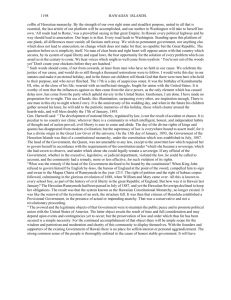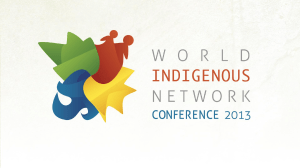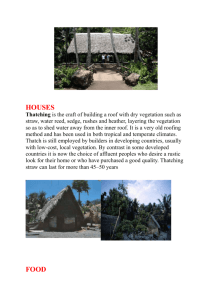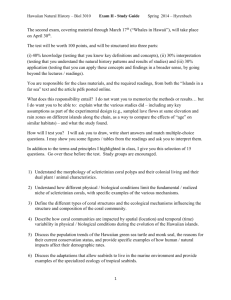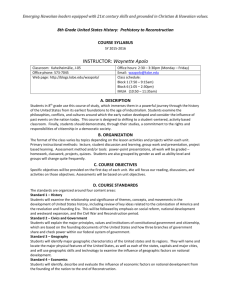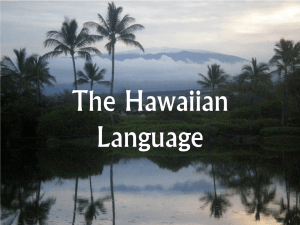mälama pono i ka 'äina– an overview of the hawaiian cultural
advertisement
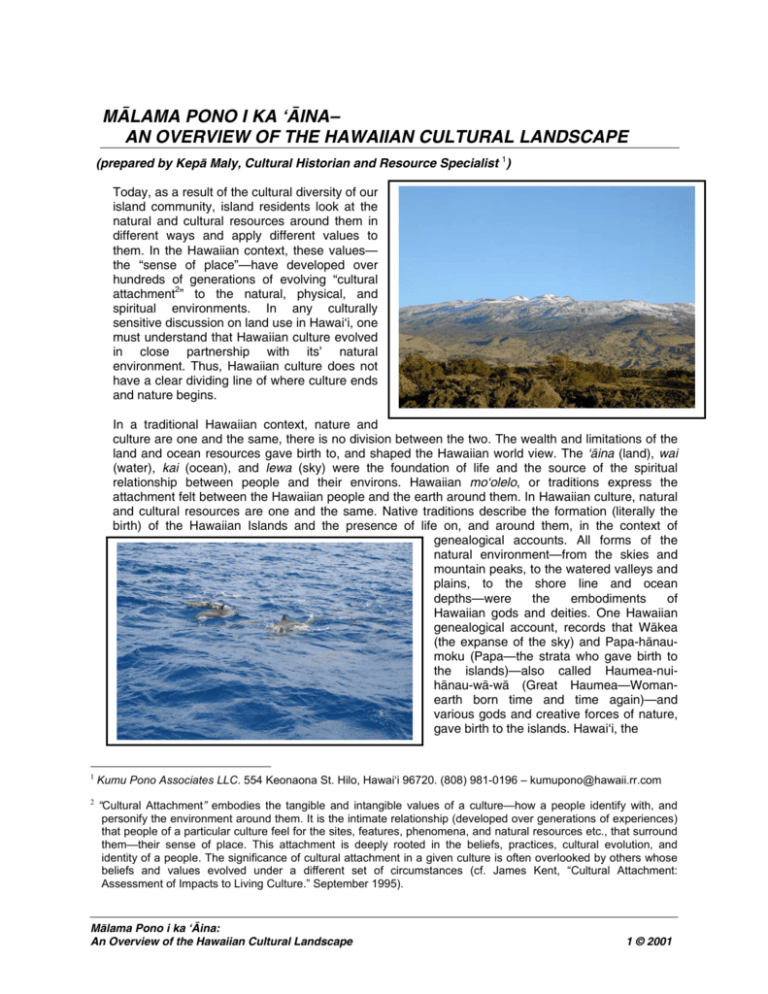
MÄLAMA PONO I KA ‘ÄINA– AN OVERVIEW OF THE HAWAIIAN CULTURAL LANDSCAPE (prepared by Kepä Maly, Cultural Historian and Resource Specialist 1) Today, as a result of the cultural diversity of our island community, island residents look at the natural and cultural resources around them in different ways and apply different values to them. In the Hawaiian context, these values— the “sense of place”—have developed over hundreds of generations of evolving “cultural attachment2” to the natural, physical, and spiritual environments. In any culturally sensitive discussion on land use in Hawai‘i, one must understand that Hawaiian culture evolved in close partnership with its’ natural environment. Thus, Hawaiian culture does not have a clear dividing line of where culture ends and nature begins. In a traditional Hawaiian context, nature and culture are one and the same, there is no division between the two. The wealth and limitations of the land and ocean resources gave birth to, and shaped the Hawaiian world view. The ‘äina (land), wai (water), kai (ocean), and lewa (sky) were the foundation of life and the source of the spiritual relationship between people and their environs. Hawaiian mo‘olelo, or traditions express the attachment felt between the Hawaiian people and the earth around them. In Hawaiian culture, natural and cultural resources are one and the same. Native traditions describe the formation (literally the birth) of the Hawaiian Islands and the presence of life on, and around them, in the context of genealogical accounts. All forms of the natural environment—from the skies and mountain peaks, to the watered valleys and plains, to the shore line and ocean depths—were the embodiments of Hawaiian gods and deities. One Hawaiian genealogical account, records that Wäkea (the expanse of the sky) and Papa-hänaumoku (Papa—the strata who gave birth to the islands)—also called Haumea-nuihänau-wä-wä (Great Haumea—Womanearth born time and time again)—and various gods and creative forces of nature, gave birth to the islands. Hawai‘i, the 1 Kumu Pono Associates LLC. 554 Keonaona St. Hilo, Hawai‘i 96720. (808) 981-0196 – kumupono@hawaii.rr.com 2 “Cultural Attachment” embodies the tangible and intangible values of a culture—how a people identify with, and personify the environment around them. It is the intimate relationship (developed over generations of experiences) that people of a particular culture feel for the sites, features, phenomena, and natural resources etc., that surround them—their sense of place. This attachment is deeply rooted in the beliefs, practices, cultural evolution, and identity of a people. The significance of cultural attachment in a given culture is often overlooked by others whose beliefs and values evolved under a different set of circumstances (cf. James Kent, “Cultural Attachment: Assessment of Impacts to Living Culture.” September 1995). Mälama Pono i ka ‘Äina: An Overview of the Hawaiian Cultural Landscape 1 © 2001 largest of the islands, was the first-born of these island children. Respect and care for nature, in turn meant that nature would care for the people. Thus, Hawaiian culture, for the most part, evolved in a healthy relationship with the nature around it, and until the arrival of foreigners on Hawaiian shores, the health and well-being of the people was reflected in the health of nature around them. In Hawaiian genealogical accounts we also find that the same god-beings, or creative forces of nature who gave birth to the islands, were also the parents of the first man (Häloa), and from this ancestor, all Hawaiian people are descended (cf. David Malo 1951:3; Beckwith 1970; Pukui and Korn 1973). One of the ancient mele (chants) handed down through the generations, that records the mo‘okū‘auhau (genealogy) of the islands records: ‘O Wäkea Kahikoluamea ea, ‘O Papa, Papa-nui-hänau-moku ka wahine; Hänau o Kahiki-kü, Kahiki-moe Hänau ke ‘äpapanu‘u, Hänau ke ‘äpapalani, Hänau Hawai‘i i ka moku makahiapo, Ke keiki makahiapo a läua… Wākea the son of Kahikoluamea, Papa, Papa-nui-hänau-moku the wife Kahiki-kü and Kahiki-moe were born The upper stratum was born, The uppermost stratum was born, Hawai‘i was born, the first-born of the islands, The first born child of the two… (S.M. Kamakau 1991:126) Through the brief narratives cited above, one begins to sense that in a traditional context, natural resources—such as rock outcrops, a pool of water, a forest grove, an ocean current, a mountain, the flat land expanse, the small hill and the natural lay of the land, and all creatures from the sea, land and air—are all valued as cultural properties by the Hawaiian people. It is this “cultural attachment” to the natural world that defines a significant body of traditional cultural properties and cultural practices of the Hawaiian people. Environmental Zones and Hawaiian Land Management In a discussion of the Hawaiian landscape it is also appropriate to briefly discuss traditional Hawaiian land terms and land management customs. It is important for contemporary readers to know that in the Hawaiian mind all aspects of the land—all natural and cultural resources are interrelated, and that all are culturally significant. The integrity of the land- and ocean- scapes (landscape), and their sense of place depends upon the well-being of the whole entity, not only a part of it. Thus, what we do on one part of the landscape has an affect on the rest of it. In this system, properly planned, designed, and built features could ensure both physical and spiritual wellbeing for the inhabitants and resources users. To ensure that a balance and compatibility with the landscape was maintained, priests of the papa hulihonua and kuhikuhi pu‘uone (priests who specialized in knowledge of the earth, its natural systems, and the placement of structures upon the land) were called upon by high chiefs and commoners prior to undertaking and during construction projects (cf. Malo 1951:161, Kamakau 1968:8,27,47). Mälama Pono i ka ‘Äina: An Overview of the Hawaiian Cultural Landscape 2 © 2001 Hawaiian customs and practices demonstrate the belief that all portions of the land and environment are related, like members of an extended family, each environmental zone was named, and their individual attributes were known. Acknowledging the relationship of one environmental zone (wao) to another, is rooted in traditional land management practices and values. Just as place names tell us that areas are of cultural importance, the occurrence of a Hawaiian nomenclature for environmental zones also tells us that there was an intimate relationship between Hawaiians and their environment. The native tradition of Ka-Miki (in Ka Hoku o Hawai‘i, 1914-1917), provides readers with a detailed account of Hawaiian land divisions and environmental zones. While competing in a riddling contest at the court of the chief, Palikū-a-Kīko‘oko‘o, the hero, Ka-Miki sparred with Pïna‘au, the foremost riddler of the district of Hilo Palikū (northern Hilo). The riddles covered topics describing regions from the mountain tips to the depths of the ocean, and descriptions of kalo (taro growth), the ala loa (trail systems), and nä mea lawai‘a (fishing practices). As the contest unfolded, it was seen that each of the competitors were well matched. In one of the riddles, Ka-Miki described the various regions of the island of Hawai‘i, extending from the mountain to the sea. Ka-Miki then told his opponent, that if he could rise to the challenge of answering the riddle, his knowledge could be compared to one who has ascended to the summit of the “mauna o Poliahu” (mountain of Poli‘ahu, or Mauna Kea) (in Ka Hoku o Hawai‘i, September 21, 1916). Through one of the riddles reader learn about the traditional wao or regions of land, districts, and land divisions of the administrators who kept peace upon the land (diacritical marks have been added to these texts). The environmental zones include: 1–Ke kuahiwi; 2–Ke kualono; 3–Ke kuamauna; 4–Ke ku(a)hea; 5–Ke kaolo; 6–Ka wao; 7–Ka wao ma‘u kele; 8–Ka wao kele; 9–Ka wao akua; 10–Ka wao lä‘au; 11–Ka wao känaka; 12–Ka ‘ama‘u; 13– Ka ‘äpa‘a; 14–Ka pahe‘e; 15–Ke kula; 16–Ka ‘ilima; 17–Ka pu‘eone; 18–Ka po‘ina nalu; 19–Ke kai kohola; 20–Ke kai ‘ele; 21–Ke kai uli; 22–Ke kai pualena; 23–Kai pōpolohua-a-Käne-i-Tahiti. 1–The mountain; 2–The region near the mountain top; 3–The mountain top; 4–The misty ridge; 5–The trail ways; 6–The inland regions; 7 and 8– The rain belt regions; 9– The distant area inhabited by gods; 10–The forested region; 11–The region of people below; 12–The place of ‘ama‘u [fern upland agricultural zone]; 13– The arid plains; 14–The place of wet land planting; 15–The plain or open country; 16–The place of ‘ilima growth [a seaward, and generally arid section of the kula]; 17–The dunes; 18–The place covered by waves [shoreline]; 19–The shallow sea [shoreline reef flats]; 20–The dark sea; 21–The deep blue-green sea; 22–The yellow [sun reflecting– sea on the horizon]; and 23–The deep purplish black sea of Käne at Tahiti. (in Ka Hoku o Hawaii, September 21, 1916; Maly, translator) Over the centuries, as the ancient Hawaiian population grew, land use and resource management also evolved. The moku puni or islands were subdivided into land units of varying sizes, and the largest division was the moku-o-loko (district - literally: interior island). As an example, it appears that the six districts on the islands of O‘ahu and Hawai‘i, and the system of developing smaller manageable units of land became formalized by the early 1600s, in the reigns of ‘Umi-a-Lïloa and Mailekükahi (cf. Kamakau 1961 and Fornander 1996). The large districts were in turn, further divided into ‘okana or kalana (regions smaller than the moku-o-loko, yet comprising several other units of land). Mälama Pono i ka ‘Äina: An Overview of the Hawaiian Cultural Landscape 3 © 2001 In the system of traditional land management, the next, and perhaps most important unit of land was the ahupua‘a; subdivisions of land whose boundaries were usually marked by altars with images of a pig, carved of kukui wood, placed upon them. The ahupua‘a within which the native Hawaiians lived, represented land divisions that were complete ecological and economic production systems. The boundaries of the ahupua‘a were generally defined by cycles and patterns of natural resources that extended from the mountainous zone, or peaks, to the ocean fisheries. The natural cycles within the ahupua‘a were also the foundation of the Hawaiian family, social, political and religious structure, and it can be said that the Hawaiian culture itself, is rooted in the land. This concept is demonstrated in the Hawaiian saying – “He kalo kanu o ka ‘äina,” which translates literally as “A taro planted on the land.” The saying has been used for generations, to describe someone who was a native of a particular land (Pukui 1983:1447). The ahupua‘a, like the larger districts they belonged to, were also divided into smaller manageable parcels. Among the smaller land units that were identified by the ancient Hawaiians were the: ‘ili lele and ‘ili kupono, were detached parcels with resources in various environmental zones; kïhäpai, both lo‘i (pond fields) and dry gardens; mäla, dryland agricultural systems; and kö‘ele, agricultural parcels worked by commoners for the chiefs. These smaller parcels were inhabited and managed by the maka‘äinana (people of the land) and their extended families. In each ahupua‘a—from mountain slopes to the ocean—the common people were generally allowed access to all of the various natural resources within a given ahupua‘a (cf. Kamakau 1961, Boundary Commission Testimonies 18731890, and Handy, Handy, and Pukui 1972). Entire ahupua‘a, or portions of the land were generally under the jurisdiction of appointed konohiki or lesser chieflandlords, who answered to an ali‘i-‘aiahupua‘a (chief who controlled the ahupua‘a resources). The ali‘i-‘ai-ahupua‘a in turn answered to an ali‘i ‘ai moku (chief who claimed the abundance of the entire district). Thus, ahupua‘a resources also supported the royal community of regional and/or island kingdoms. This form of district subdividing and resource management was integral to Hawaiian life and was the product of strictly adhered to planning methodology. Such a system, incorporating traditional knowledge, with modern sciences and planning approaches, would benefit all members of our island community in the present-day. Mälama Pono i ka ‘Äina: An Overview of the Hawaiian Cultural Landscape 4 © 2001 REFERENCES CITED Beckwith, M. 1970 Hawaiian Mythology. Honolulu: University of Hawaii Press. Boundary Commission Testimony 1873-1915 Digitized volumes in Collection of Kumu Pono Associated LLC (from Hawaii State Archives). Fornander, A. l996 Ancient History of the Hawaiian People. Mutual Publishing, Australia. Handy, E.S.C., E.G. Handy, with M.K. Pukui 1972 Native Planters in Old Hawaii, Their Life, Lore, and Environment. B.P. Bishop Museum Bulletin 233. B.P. Bishop Museum Press. Kamakau, S.M. 1961 Ruling Chiefs of Hawaii. Honolulu: Kamehameha Schools Press. 1968 Ka Po‘e Kahiko: The People of Old. B.P. Bishop Museum Special Publication 51. Bishop Museum Press, Honolulu. 1991 Tales and Traditions of the People of Old, Nä Mo‘olelo a ka Po‘e Kahiko. Bishop Museum Press, Honolulu. Malo, D. 1951 Hawaiian Antiquities. Honolulu, B.P. Bishop Museum. Maly, Kepä (translator) ms. Kaao Hooniua Puuwai no Ka-Miki (The Heart Stirring Story of Ka-Miki). Translation of a traditional account of people and places of the island of Hawai‘i. Published in the Hawaiian Newspaper Ka Hoku o Hawaii; January 8, 1914 - December 6, 1917. Pukui, M.K. 1983 Olelo No‘eau. B.P. Bishop Museum Special Publication 71. Bishop Museum Press, Honolulu. Pukui, M.K., and A.L. Korn 1973 The Echo of Our Song. Chants and Poems of the Hawaiians. Honolulu: University Press of Hawaii. Mälama Pono i ka ‘Äina: An Overview of the Hawaiian Cultural Landscape 5 © 2001

